Suzan Verberne
Iterative Self-Incentivization Empowers Large Language Models as Agentic Searchers
May 26, 2025Abstract:Large language models (LLMs) have been widely integrated into information retrieval to advance traditional techniques. However, effectively enabling LLMs to seek accurate knowledge in complex tasks remains a challenge due to the complexity of multi-hop queries as well as the irrelevant retrieved content. To address these limitations, we propose EXSEARCH, an agentic search framework, where the LLM learns to retrieve useful information as the reasoning unfolds through a self-incentivized process. At each step, the LLM decides what to retrieve (thinking), triggers an external retriever (search), and extracts fine-grained evidence (recording) to support next-step reasoning. To enable LLM with this capability, EXSEARCH adopts a Generalized Expectation-Maximization algorithm. In the E-step, the LLM generates multiple search trajectories and assigns an importance weight to each; the M-step trains the LLM on them with a re-weighted loss function. This creates a self-incentivized loop, where the LLM iteratively learns from its own generated data, progressively improving itself for search. We further theoretically analyze this training process, establishing convergence guarantees. Extensive experiments on four knowledge-intensive benchmarks show that EXSEARCH substantially outperforms baselines, e.g., +7.8% improvement on exact match score. Motivated by these promising results, we introduce EXSEARCH-Zoo, an extension that extends our method to broader scenarios, to facilitate future work.
Unifying Search and Recommendation: A Generative Paradigm Inspired by Information Theory
Apr 09, 2025Abstract:Recommender systems and search engines serve as foundational elements of online platforms, with the former delivering information proactively and the latter enabling users to seek information actively. Unifying both tasks in a shared model is promising since it can enhance user modeling and item understanding. Previous approaches mainly follow a discriminative paradigm, utilizing shared encoders to process input features and task-specific heads to perform each task. However, this paradigm encounters two key challenges: gradient conflict and manual design complexity. From the information theory perspective, these challenges potentially both stem from the same issue -- low mutual information between the input features and task-specific outputs during the optimization process. To tackle these issues, we propose GenSR, a novel generative paradigm for unifying search and recommendation (S&R), which leverages task-specific prompts to partition the model's parameter space into subspaces, thereby enhancing mutual information. To construct effective subspaces for each task, GenSR first prepares informative representations for each subspace and then optimizes both subspaces in one unified model. Specifically, GenSR consists of two main modules: (1) Dual Representation Learning, which independently models collaborative and semantic historical information to derive expressive item representations; and (2) S&R Task Unifying, which utilizes contrastive learning together with instruction tuning to generate task-specific outputs effectively. Extensive experiments on two public datasets show GenSR outperforms state-of-the-art methods across S&R tasks. Our work introduces a new generative paradigm compared with previous discriminative methods and establishes its superiority from the mutual information perspective.
SPILL: Domain-Adaptive Intent Clustering based on Selection and Pooling with Large Language Models
Mar 19, 2025Abstract:In this paper, we propose Selection and Pooling with Large Language Models (SPILL), an intuitive and domain-adaptive method for intent clustering without fine-tuning. Existing embeddings-based clustering methods rely on a few labeled examples or unsupervised fine-tuning to optimize results for each new dataset, which makes them less generalizable to multiple datasets. Our goal is to make these existing embedders more generalizable to new domain datasets without further fine-tuning. Inspired by our theoretical derivation and simulation results on the effectiveness of sampling and pooling techniques, we view the clustering task as a small-scale selection problem. A good solution to this problem is associated with better clustering performance. Accordingly, we propose a two-stage approach: First, for each utterance (referred to as the seed), we derive its embedding using an existing embedder. Then, we apply a distance metric to select a pool of candidates close to the seed. Because the embedder is not optimized for new datasets, in the second stage, we use an LLM to further select utterances from these candidates that share the same intent as the seed. Finally, we pool these selected candidates with the seed to derive a refined embedding for the seed. We found that our method generally outperforms directly using an embedder, and it achieves comparable results to other state-of-the-art studies, even those that use much larger models and require fine-tuning, showing its strength and efficiency. Our results indicate that our method enables existing embedders to be further improved without additional fine-tuning, making them more adaptable to new domain datasets. Additionally, viewing the clustering task as a small-scale selection problem gives the potential of using LLMs to customize clustering tasks according to the user's goals.
QUIDS: Query Intent Generation via Dual Space Modeling
Oct 16, 2024



Abstract:Query understanding is a crucial component of Information Retrieval (IR), aimed at identifying the underlying search intent of textual queries. However, most existing approaches oversimplify this task into query classification or clustering, which fails to fully capture the nuanced intent behind the query. In this paper, we address the task of query intent generation: to automatically generate detailed and precise intent descriptions for search queries using relevant and irrelevant documents given a query. These intent descriptions can help users understand why the search engine considered the top-ranked documents relevant, and provide more transparency to the retrieval process. We propose a dual-space model that uses semantic relevance and irrelevance information in the returned documents to explain the understanding of the query intent. Specifically, in the encoding process, we project, separate, and distinguish relevant and irrelevant documents in the representation space. Then, we introduce a semantic decoupling model in the novel disentangling space, where the semantics of irrelevant information are removed from the relevant space, ensuring that only the essential and relevant intent is captured. This process refines the understanding of the query and provides more accurate explanations for the search results. Experiments on benchmark data demonstrate that our methods produce high-quality query intent descriptions, outperforming existing methods for this task, as well as state-of-the-art query-based summarization methods. A token-level visualization of attention scores reveals that our model effectively reduces the focus on irrelevant intent topics. Our findings open up promising research and application directions for query intent generation, particularly in exploratory search.
Evaluation of Attribution Bias in Retrieval-Augmented Large Language Models
Oct 16, 2024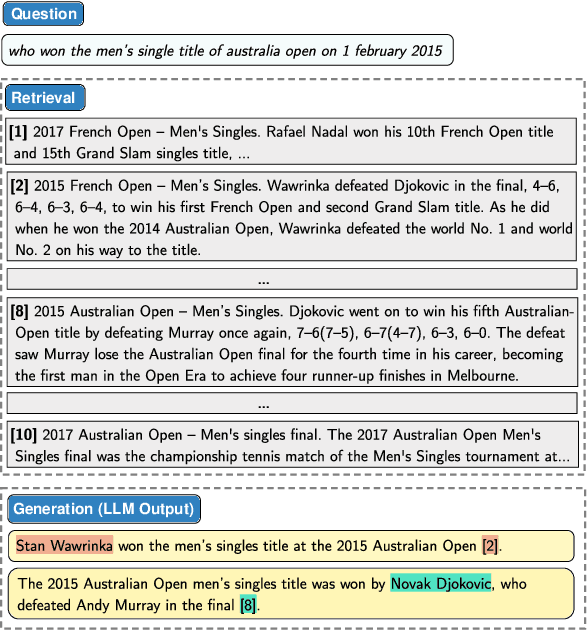
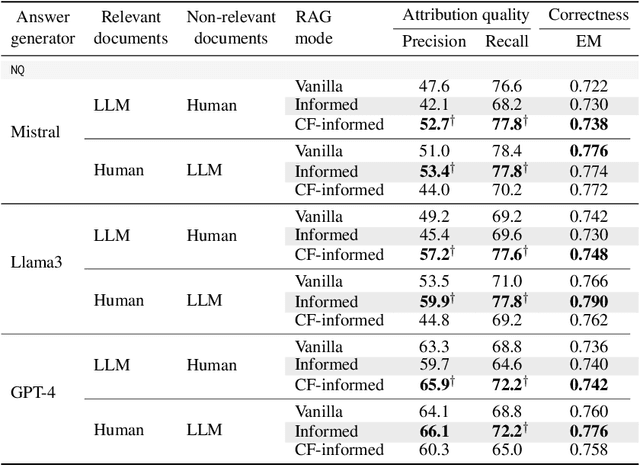
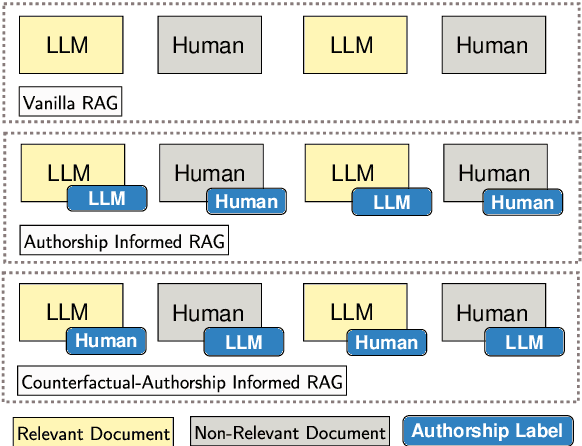

Abstract:Attributing answers to source documents is an approach used to enhance the verifiability of a model's output in retrieval augmented generation (RAG). Prior work has mainly focused on improving and evaluating the attribution quality of large language models (LLMs) in RAG, but this may come at the expense of inducing biases in the attribution of answers. We define and examine two aspects in the evaluation of LLMs in RAG pipelines, namely attribution sensitivity and bias with respect to authorship information. We explicitly inform an LLM about the authors of source documents, instruct it to attribute its answers, and analyze (i) how sensitive the LLM's output is to the author of source documents, and (ii) whether the LLM exhibits a bias towards human-written or AI-generated source documents. We design an experimental setup in which we use counterfactual evaluation to study three LLMs in terms of their attribution sensitivity and bias in RAG pipelines. Our results show that adding authorship information to source documents can significantly change the attribution quality of LLMs by 3% to 18%. Moreover, we show that LLMs can have an attribution bias towards explicit human authorship, which can serve as a competing hypothesis for findings of prior work that shows that LLM-generated content may be preferred over human-written contents. Our findings indicate that metadata of source documents can influence LLMs' trust, and how they attribute their answers. Furthermore, our research highlights attribution bias and sensitivity as a novel aspect of brittleness in LLMs.
Undesirable Memorization in Large Language Models: A Survey
Oct 03, 2024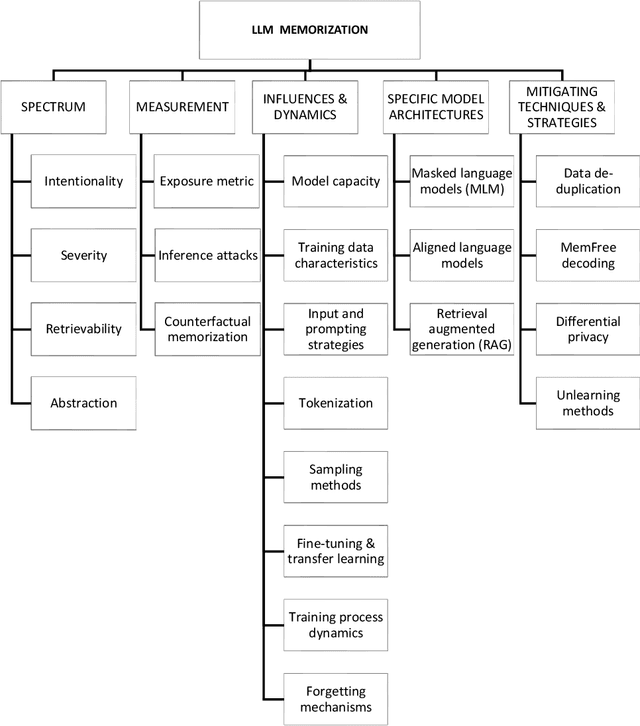
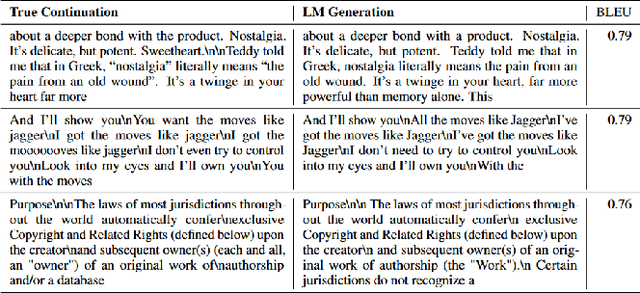
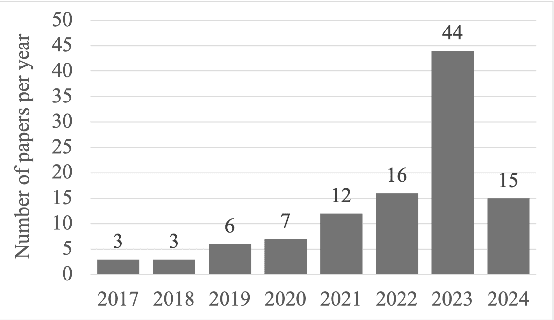

Abstract:While recent research increasingly showcases the remarkable capabilities of Large Language Models (LLMs), it's vital to confront their hidden pitfalls. Among these challenges, the issue of memorization stands out, posing significant ethical and legal risks. In this paper, we presents a Systematization of Knowledge (SoK) on the topic of memorization in LLMs. Memorization is the effect that a model tends to store and reproduce phrases or passages from the training data and has been shown to be the fundamental issue to various privacy and security attacks against LLMs. We begin by providing an overview of the literature on the memorization, exploring it across five key dimensions: intentionality, degree, retrievability, abstraction, and transparency. Next, we discuss the metrics and methods used to measure memorization, followed by an analysis of the factors that contribute to memorization phenomenon. We then examine how memorization manifests itself in specific model architectures and explore strategies for mitigating these effects. We conclude our overview by identifying potential research topics for the near future: to develop methods for balancing performance and privacy in LLMs, and the analysis of memorization in specific contexts, including conversational agents, retrieval-augmented generation, multilingual language models, and diffusion language models.
Generate then Refine: Data Augmentation for Zero-shot Intent Detection
Oct 02, 2024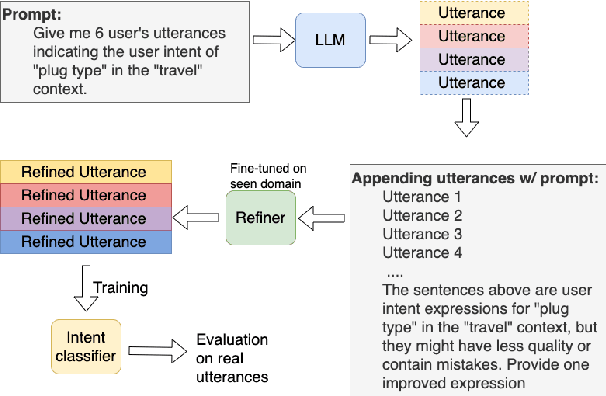
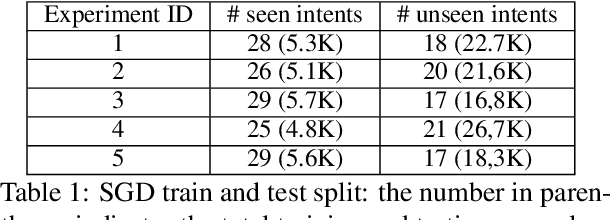
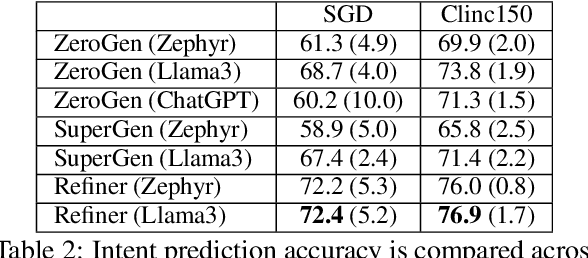
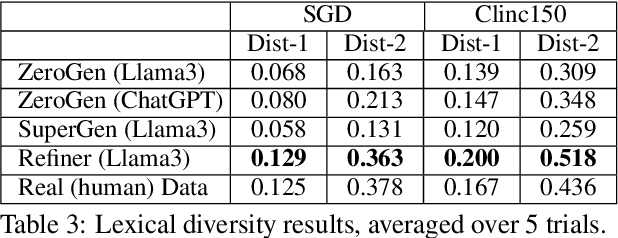
Abstract:In this short paper we propose a data augmentation method for intent detection in zero-resource domains. Existing data augmentation methods rely on few labelled examples for each intent category, which can be expensive in settings with many possible intents. We use a two-stage approach: First, we generate utterances for intent labels using an open-source large language model in a zero-shot setting. Second, we develop a smaller sequence-to-sequence model (the Refiner), to improve the generated utterances. The Refiner is fine-tuned on seen domains and then applied to unseen domains. We evaluate our method by training an intent classifier on the generated data, and evaluating it on real (human) data. We find that the Refiner significantly improves the data utility and diversity over the zero-shot LLM baseline for unseen domains and over common baseline approaches. Our results indicate that a two-step approach of a generative LLM in zero-shot setting and a smaller sequence-to-sequence model can provide high-quality data for intent detection.
What are the limits of cross-lingual dense passage retrieval for low-resource languages?
Aug 21, 2024



Abstract:In this paper, we analyze the capabilities of the multi-lingual Dense Passage Retriever (mDPR) for extremely low-resource languages. In the Cross-lingual Open-Retrieval Answer Generation (CORA) pipeline, mDPR achieves success on multilingual open QA benchmarks across 26 languages, of which 9 were unseen during training. These results are promising for Question Answering (QA) for low-resource languages. We focus on two extremely low-resource languages for which mDPR performs poorly: Amharic and Khmer. We collect and curate datasets to train mDPR models using Translation Language Modeling (TLM) and question--passage alignment. We also investigate the effect of our extension on the language distribution in the retrieval results. Our results on the MKQA and AmQA datasets show that language alignment brings improvements to mDPR for the low-resource languages, but the improvements are modest and the results remain low. We conclude that fulfilling CORA's promise to enable multilingual open QA in extremely low-resource settings is challenging because the model, the data, and the evaluation approach are intertwined. Hence, all three need attention in follow-up work. We release our code for reproducibility and future work: https://anonymous.4open.science/r/Question-Answering-for-Low-Resource-Languages-B13C/
Generative Retrieval with Few-shot Indexing
Aug 04, 2024



Abstract:Existing generative retrieval (GR) approaches rely on training-based indexing, i.e., fine-tuning a model to memorise the associations between a query and the document identifier (docid) of a relevant document. Training-based indexing has three limitations: high training overhead, under-utilization of the pre-trained knowledge of large language models (LLMs), and challenges in adapting to a dynamic document corpus. To address the above issues, we propose a novel few-shot indexing-based GR framework (Few-Shot GR). It has a novel few-shot indexing process, where we prompt an LLM to generate docids for all documents in a corpus, ultimately creating a docid bank for the entire corpus. During retrieval, we feed a query to the same LLM and constrain it to generate a docid within the docid bank created during indexing, and then map the generated docid back to its corresponding document. Few-Shot GR relies solely on prompting an LLM without requiring any training, making it more efficient. Moreover, we devise few-shot indexing with one-to-many mapping to further enhance Few-Shot GR. Experiments show that Few-Shot GR achieves superior performance to state-of-the-art GR methods that require heavy training.
Reasoning with Large Language Models, a Survey
Jul 16, 2024



Abstract:Scaling up language models to billions of parameters has opened up possibilities for in-context learning, allowing instruction tuning and few-shot learning on tasks that the model was not specifically trained for. This has achieved breakthrough performance on language tasks such as translation, summarization, and question-answering. Furthermore, in addition to these associative "System 1" tasks, recent advances in Chain-of-thought prompt learning have demonstrated strong "System 2" reasoning abilities, answering a question in the field of artificial general intelligence whether LLMs can reason. The field started with the question whether LLMs can solve grade school math word problems. This paper reviews the rapidly expanding field of prompt-based reasoning with LLMs. Our taxonomy identifies different ways to generate, evaluate, and control multi-step reasoning. We provide an in-depth coverage of core approaches and open problems, and we propose a research agenda for the near future. Finally, we highlight the relation between reasoning and prompt-based learning, and we discuss the relation between reasoning, sequential decision processes, and reinforcement learning. We find that self-improvement, self-reflection, and some metacognitive abilities of the reasoning processes are possible through the judicious use of prompts. True self-improvement and self-reasoning, to go from reasoning with LLMs to reasoning by LLMs, remains future work.
 Add to Chrome
Add to Chrome Add to Firefox
Add to Firefox Add to Edge
Add to Edge